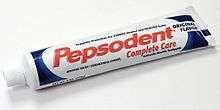Pepsodent

Pepsodent is an American brand of toothpaste with a minty flavour derived from sassafras. It has been owned by Unilever since 1942, except in the US and Canada, where since 2003, it has been owned by Church & Dwight.[1]
History
Pepsodent toothpaste was introduced in the USA in 1915 by the Pepsodent Company of Chicago. The original formula for the paste contained pepsin, a digestive agent designed to break down and digest food deposits on the teeth, hence the brand and company name.
In the 1930s a massive animated neon advertising sign, featuring a young girl on a swing, hung on a building in Times Square in New York City. (This ad was re-created for the climax of the 2005 film King Kong.)
Following the acquisition of the Pepsodent Company by Unilever in 1944, sales of Pepsodent in the UK increased rapidly, more than doubling between 1944 and 1950. The company outgrew its original factory in Park Royal, and the manufacture of the product was moved to the factory of another Unilever-owned toiletry manufacturer, Joseph Watson and Sons of Whitehall Road, Leeds, in 1951.
Pepsodent was a very popular brand before the mid-1950s, but its makers were slow to add fluoride to its formula to counter the rise of other highly promoted brands such as Crest and Gleem toothpaste by Procter & Gamble, and Colgate's eponymous product; sales of Pepsodent plummeted. Today Pepsodent is a “value brand” marketed primarily in discount stores and retails for roughly half the price of similarly sized tubes of Crest or of Colgate.
The product was discontinued in South Africa in 1974 but was revived in 1976 with a new ad slogan "Gets Your Teeth Their Whitest" featuring celebrity endorsers Rita Moreno, Steve Lawrence, and others. The popular slogan was also changed in South Africa to "You'll wonder where the dullness went / when you polish your teeth with Pepsodent".
Pepsodent is still sold as a Unilever property in all markets except the United States and Canada. In Vietnam, Pepsodent is called P/S. In 2013, Pepsodent was ranked 201st among India's most trusted brands according to the Brand Trust Report 2013 India study, a research conducted by Trust Research Advisory. According to the Brand trust Report 2014, Pepsodent moved up to 71st position among India's most trusted brands. Pepsodent's parent company Hindustan Unilever was ranked 47th in the Trust Report 2014.[2]
Advertising
.jpg)
Pepsodent was advertised for its purported properties for fighting tooth decay, attributed in advertisements to the supposed ingredient Irium. In a 1994 speech, the chairman of the U.S. Federal Communications Commission, Reed Hundt, claimed that the "Irium" mentioned in Pepsodent advertisements "didn't exist".[3] "Irium" was another name for sodium lauryl sulfate, an ionic surfactant.[4]
Another ingredient, "I.M.P.", which stood for "Insoluble Meta-Phosphate",[5] was purported to whiten teeth. Its best-known slogan was “You'll wonder where the yellow went / when you brush your teeth with Pepsodent!”, adapted by UK school kids to "You'll wonder where your teeth have gone/ when you brush them with an atom bomb". British comedian Jasper Carrott referred to the slogan in one of his stand-up routines, saying “On your tongue — that's where the yellow went!”
Radio program
Pepsodent sponsored a radio program, The Pepsodent Show Starring Bob Hope that began airing in 1938 and ran for approximately 10 years on NBC. The show featured Bob Hope and his cast of regular characters such as Jerry Colonna, Barbara Jo Allen as Vera Vague, Frances Langford, and Skinnay Ennis.
Famous Hollywood guest stars such as Cary Grant, Orson Welles, Judy Garland, Bette Davis, Humphrey Bogart, Paulette Goddard, Dorothy Lamour, Rita Hayworth, Penny Singleton, Arthur Lake, Basil Rathbone, Gary Cooper, Veronica Lake, Ginger Rogers, Edward G. Robinson, Hedda Hopper, and many more would be on hand to trade comedic barbs with Hope. The show was the first radio program to broadcast live from the Hollywood Canteen on October 13, 1942, and soon the show was playing live to U.S. troops during World War II, even including some of the soldiers in the show.
In popular culture
In the Rodgers and Hammerstein play South Pacific, in the song "Bloody Mary", a few lines refer to Pepsodent:
Bloody Mary's chewing betel nuts.
She is always chewing betel nuts.
Bloody Mary's chewing betel nuts,
And she don't use Pepsodent.
It's also referenced in some versions of Cole Porter's song You're The Top:
You're an old Dutch master, you're Mrs. Astor,
You're Pepsodent.
In the Broadway musical Annie, Pepsodent is the inspiration for the fictional brand of toothpaste, "Oxydent" (named "Iodent" in the 1982 motion picture), and the famous Times Square sign can be seen parodied in the original Broadway set design for the number "N.Y.C". Like Pepsodent, Oxydent also sponsors a radio show, the "Oxydent Hour of Smiles", however the radio show may be more inspired by Fred Allen's Hour of Smiles.
Another famous instance of Pepsodent is from an old Mad Magazine circa 1960s. It had a realistic cartoon of Leonardo da Vinci looking at his easel, sitting in front of the Mona Lisa, thinking, "I wonder where the yellow went?" Among the tubes of paint is a tube of Pepsodent.
See also
References
- ↑ "Church & Dwight Agrees to Purchase Unilever's Oral Care Brands in the U.S. and Canada; Transaction Will Strengthen Company's 'Strategically Important Oral Care Business'" (Press release). Princeton, New Jersey: Church & Dwight. Business Wire. 10 September 2003. Retrieved 7 July 2015.
- ↑ "India's Most Trusted Brands 2014". The Brand Trust Report.
- ↑ Hundt, Reed E. (October 13, 1994). "Address Before the NAB Radio Show". Retrieved 2007-08-21.
- ↑ Budavari, Susan; O'Neil, Maryadele J.; Smith, Ann; Heckelman, Patricia E.; Kinneary, Joanne F. (1996). "sodium lauryl sulfate". The Merck Index (12th ed.). Whitehouse Station, New Jersey: Merk & Co., Inc. p. 1478.
- ↑ "Pepsodent Advertisement". Life. Time Inc: 1. 22 August 1955. ISSN 0024-3019. Retrieved 18 March 2013.
External links
| Wikimedia Commons has media related to Pepsodent. |